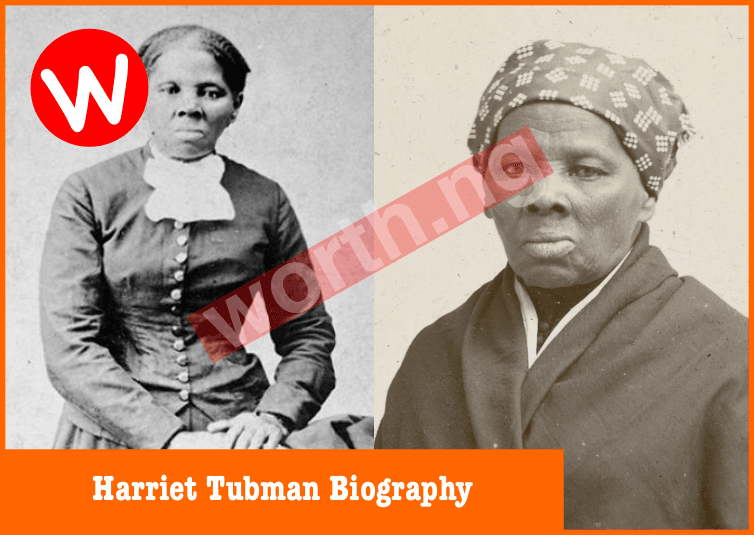
Harriet Tubman Biography – Discover the inspiring life of Harriet Tubman, her role in the Underground Railroad, her early life, family, age, and legacy, including the events leading to her death.
Harriet Tubman remains one of the most iconic figures in American history, known for her unwavering courage and tireless efforts to abolish slavery. Born into enslavement, she escaped and dedicated her life to helping others achieve freedom, guiding hundreds to safety through the Underground Railroad.
In addition to her activism, Harriet served as a Union scout and nurse during the Civil War. Her legacy is a testament to resilience, justice, and the power of one individual to inspire change. This post explores Harriet Tubman’s remarkable journey, her family, contributions to the Underground Railroad, and her enduring influence.
Harriet Tubman Biography: Personal Information
| Field | Details |
|---|---|
| Full Name | Harriet Tubman (Araminta “Minty” Ross) |
| Born | 1822 in Dorchester County, Maryland, USA |
| Parents | Harriet “Rit” Green and Ben Ross |
| Siblings | Had eight siblings; many remained enslaved |
| Net Worth | No monetary wealth; legacy of freedom and justice |
| Underground Railroad | Freed over 70 individuals; worked as a conductor |
| Civil War Role | Nurse, spy, and scout for the Union Army |
| Death | March 10, 1913, in Auburn, New York |
Key Takeaways
- Full Name: Harriet Tubman (born Araminta Ross).
- Net Worth: While she had no formal wealth, her legacy is priceless.
- Age: Born in 1822, Harriet Tubman lived to approximately 91 years old.
- Family: Daughter of enslaved parents Harriet “Rit” Green and Ben Ross.
- Major Contribution: Leading over 70 enslaved individuals to freedom via the Underground Railroad.
- Death: Passed away on March 10, 1913, in Auburn, New York.
Early Life of Harriet Tubman
Harriet Tubman, originally named Araminta Ross, was born into slavery in Dorchester County, Maryland, around 1822. The daughter of enslaved parents Harriet “Rit” Green and Ben Ross, she experienced the harsh realities of slavery from a young age.
Her early life was marked by physical and emotional hardship. Harriet suffered a traumatic head injury at the age of 13, which resulted in lifelong health complications but also inspired her deep religious visions and sense of purpose. Despite these challenges, her resilience and faith became driving forces in her journey to freedom.
The Underground Railroad and Harriet’s Contributions
After escaping slavery in 1849, Harriet Tubman made it her mission to lead others to freedom. Using the Underground Railroad, a network of safe houses and abolitionist supporters, Harriet guided over 70 enslaved individuals to freedom, earning her the nickname “Moses.”
Her Tactics and Courage
Harriet’s success was rooted in her strategic planning, courage, and reliance on her faith. She often traveled at night, using the North Star for navigation and relying on her network of allies for support.
Her work with the Underground Railroad wasn’t limited to guiding others. Harriet also shared her knowledge and strategies with fellow abolitionists, furthering the cause of freedom.
Family and Personal Life
Harriet Tubman’s family played a significant role in shaping her life and mission. Despite the heartache of being separated from many family members due to slavery, she worked tirelessly to reunite her family.
Marriage and Later Life
Harriet married a free Black man, John Tubman, before her escape, but their relationship ended when she pursued freedom. Later, she married Nelson Davis, a Union soldier, in 1869. The couple adopted a daughter named Gertie. Harriet’s family life, though marked by loss and struggle, was a source of strength and motivation.
Harriet Tubman’s Role in the Civil War
During the Civil War, Harriet Tubman served as a nurse, cook, and scout for the Union Army. Her most notable achievement was leading a raid at Combahee Ferry in South Carolina, which resulted in the liberation of over 700 enslaved individuals.
Recognition and Challenges
Despite her significant contributions, Harriet faced financial struggles and was not paid adequately for her work during the war. Nevertheless, she continued to advocate for justice and equality, leaving an indelible mark on history.
Later Years and Legacy
In her later years, Harriet Tubman settled in Auburn, New York, where she dedicated her time to philanthropy and advocacy. She established a home for elderly African Americans and continued to fight for women’s suffrage.
Harriet Tubman passed away on March 10, 1913, at the age of 91. She was buried with military honors, a testament to her unwavering service and dedication.
Net Worth and Financial Struggles
Although Harriet Tubman did not amass monetary wealth, her contributions to freedom and justice are invaluable. She faced financial difficulties throughout her life, relying on donations and support from allies to sustain her work.
Her legacy, however, transcends material wealth, serving as a symbol of courage, resilience, and the fight for equality.
Key Achievements of Harriet Tubman
- Underground Railroad Success: Guided over 70 individuals to freedom.
- Civil War Contributions: Served as a scout, nurse, and spy for the Union Army.
- Philanthropy: Established a home for elderly African Americans.
- Advocacy: Fought for women’s suffrage in her later years.
Conclusion
Harriet Tubman’s life is a story of bravery, selflessness, and an unyielding commitment to justice. From her early days as an enslaved child to her pivotal role in the Underground Railroad and the Civil War, Harriet’s legacy continues to inspire generations.
Her impact goes beyond the pages of history, reminding us of the power of determination and the importance of standing up for what is right. Harriet Tubman’s legacy is a beacon of hope and resilience, ensuring that her story will never be forgotten.
FAQs About Harriet Tubman Biography
1. What was Harriet Tubman’s real name?
Harriet Tubman’s birth name was Araminta Ross.
2. How many people did Harriet Tubman free through the Underground Railroad?
Harriet Tubman helped free over 70 enslaved individuals directly and provided guidance for many more.
3. Did Harriet Tubman have children?
Yes, Harriet Tubman and her second husband, Nelson Davis, adopted a daughter named Gertie.
4. How did Harriet Tubman contribute to the Civil War?
Harriet Tubman served as a nurse, spy, and scout for the Union Army, notably leading a raid that freed over 700 enslaved people.
5. When and where did Harriet Tubman die?
Harriet Tubman passed away on March 10, 1913, in Auburn, New York.





